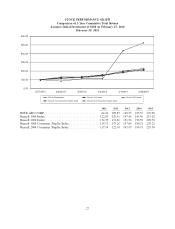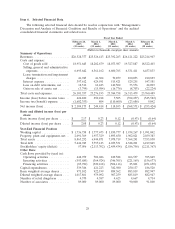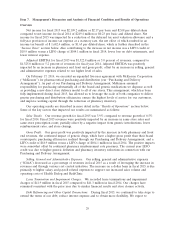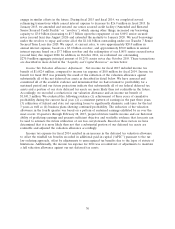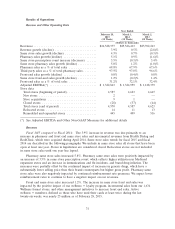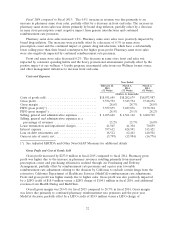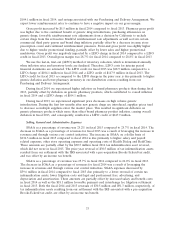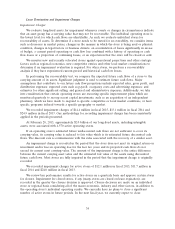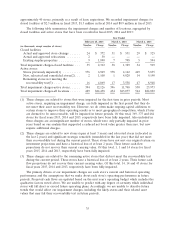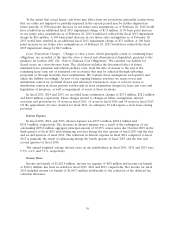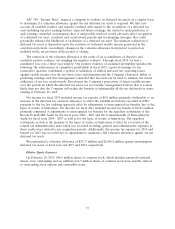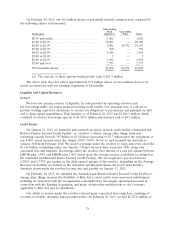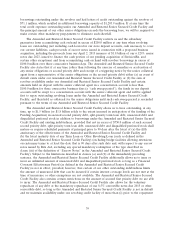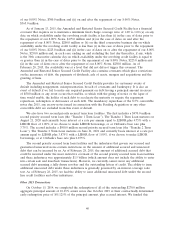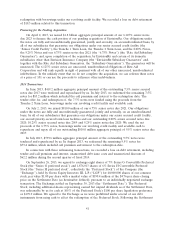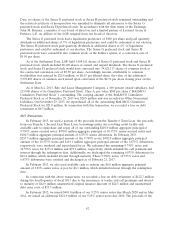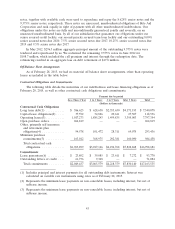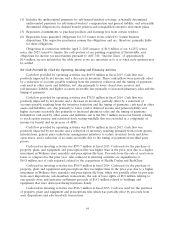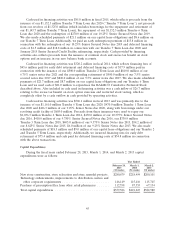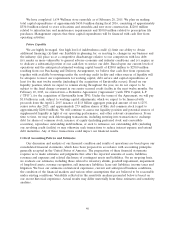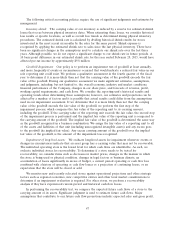Rite Aid 2015 Annual Report Download - page 37
Download and view the complete annual report
Please find page 37 of the 2015 Rite Aid annual report below. You can navigate through the pages in the report by either clicking on the pages listed below, or by using the keyword search tool below to find specific information within the annual report.ASC 740, ‘‘Income Taxes’’ requires a company to evaluate its deferred tax assets on a regular basis
to determine if a valuation allowance against the net deferred tax assets is required. We take into
account all available positive and negative evidence with regard to the recognition of a deferred tax
asset including our past earnings history, expected future earnings, the character and jurisdiction of
such earnings, unsettled circumstances that, if unfavorably resolved, would adversely affect recognition
of a deferred tax asset, carryback and carryforward periods and tax planning strategies that could
potentially enhance the likelihood of realization of a deferred tax asset. The ultimate realization of
deferred tax assets is dependent upon the existence of sufficient taxable income generated in the
carryforward periods. Accordingly, changes in the valuation allowance from period to period are
included in the tax provision in the period of change.
The reduction of the valuation allowance is the result of an accumulation of objective and
verifiable positive evidence out weighing the negative evidence. Through fiscal 2014, we had a
cumulative loss over a three year window. Our positive evidence of sustained profitability includes the
following: the achievement of cumulative profitability in fiscal 2015, reported earnings for ten
consecutive quarters, established a pattern of utilization of federal and state net operating losses
against taxable income over the last three years and demonstrated the Company’s historical ability of
predicting earnings such that management concluded that forecasts can be used to estimate the future
utilization of our loss carryforwards. Based upon the Company’s projections of future taxable income
over the periods in which the deferred tax assets are recoverable, management believes that it is more
likely than not that the Company will realize the benefits of substantially all the net deferred tax assets
existing at February 28, 2015.
Net income for fiscal 2014 included income tax expense of $0.8 million primarily attributable to an
increase in the deferred tax valuation allowance to offset the windfall tax benefits recorded in APIC
pursuant to the tax law ordering approach offset by adjustments to unrecognized tax benefits due to the
lapse of statute of limitations. Net Income for fiscal 2013 included income tax benefit of $110.6 million
primarily comprised of adjustments to unrecognized tax benefits for the appellate settlements of the
Brooks Eckerd IRS Audit for the fiscal years 2004 - 2007 and the Commonwealth of Massachusetts
Audit for fiscal years 2005 - 2007 as well as for the lapse of statute of limitations. The appellate
settlements as well as the majority of the lapse of statute of limitations is offset by a reversal of the
related tax indemnification asset which was recorded in selling, general and administrative expenses as
these audits were related to pre-acquisition periods. Additionally, the income tax expense for 2014 and
benefit for 2013 was recorded net of adjustments to maintain a full valuation allowance against our net
deferred tax assets.
We maintained a valuation allowance of $231.7 million and $2,060.8 million against remaining net
deferred tax assets at fiscal year-end 2015 and 2014, respectively.
Dilutive Equity Issuances
On February 28, 2015, 988.6 million shares of common stock, which includes unvested restricted
shares, were outstanding and an additional 66.5 million shares of common stock were issuable related
to outstanding stock options and convertible notes.
37


